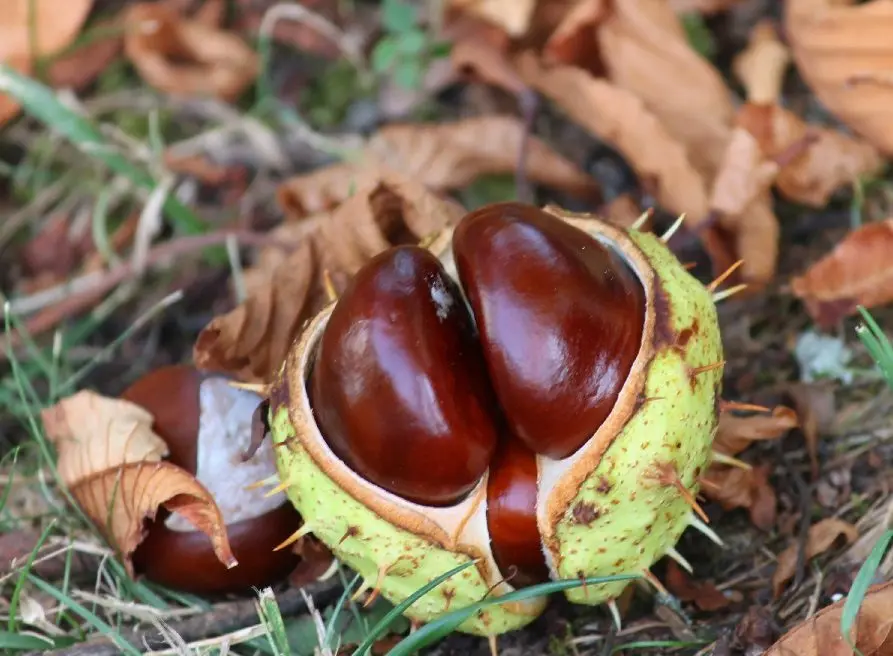Contents
Horse chestnut (Aesculus hippocastanum) is a tree that reaches a height of 40 m, it is often used in landscaping because of its abundant foliage and beautiful flowers. It differs from ordinary chestnut in that its fruits are inedible, as they contain the poisonous substance esculin. In ancient times, the bark and leaves of the plant were used to treat respiratory diseases in cattle and horses, at present, horse chestnut tincture with vodka or alcohol is used in folk medicine for adjuvant therapy for circulatory problems.
Useful properties of horse chestnut
A detailed description of the healing properties of horse chestnut is found in the King’s American Dispensatory, first published in 1854. The authors recommended using the bark for healing gangrenous ulcers, and using the pulp of nuts as a medicine for diseases associated with congestion in the vessels. The well-known herbalist Dr. med. Rudolf Weiss considers the proven effectiveness of horse chestnut tincture in the treatment of chronic venous insufficiency.
The active ingredient of the fruit is escin, which fights against the increased permeability of the vascular walls and the release of fluid into the surrounding tissues, which is often observed in various inflammatory reactions. To date, several dozen studies have been carried out on the properties of horse chestnut. The results of the experiments showed that the plant extract relieves fatigue, tension, pain and itching in venous insufficiency, and also stimulates the production of prostaglandin F-alpha, which narrows blood vessels.
In addition to aescin, horse chestnut contains:
- esculin – reduces capillary permeability, increases blood flow and filling of veins;
- fraxin – fights against increased blood clotting;
- hydroquinone – disinfects and acts as an antioxidant;
- tannins – relieve inflammation;
- flavonoids – protect cells from the penetration of free radicals.
The complex action of substances allows the use of horse chestnut in the treatment of arthritis, increased capillary fragility, edema, frostbite, rheumatism and ulcers. Ready-made tincture is sold in a pharmacy and on sites selling bioadditives. The tool can be prepared at home on the basis of self-collected raw materials.

How to make horse chestnut tincture
Horse chestnut is widely used in landscaping areas in the southern regions and central Russia. Frost-resistant species are also planted in the northern regions, but there the tree does not grow more than two meters in height.
Herbalists collect the bark and flowers of the plant, but the highest concentration of nutrients is found in its fruits, which ripen in early September. Ready-to-harvest chestnuts are covered with a green, thorny skin that often bursts, and inside is a fruit with a shiny brown skin. It is better to choose trees that grow away from busy roads.
The collected raw materials must be cleaned of green peel, then washed and dried in a colander. Peeling the skin is not required. For 0,5 liters of vodka or moonshine, 0,5 kg of chestnuts will be required.
Instructions for cooking:
- Cut the fruits into four parts.
- Put the raw materials in a glass jar (preferably dark).
- Pour 0,5 liters of vodka.
- Put in a dark cool place.
- Shake the container every 2-3 days.
- Endure a month.

Ready chestnut tincture acquires a rich brown color, it must be filtered and put in the refrigerator. The collected raw materials can later be used to re-prepare the tincture, since the fruits can be stored for several months in a dry, cold place without losing their properties.
Application of horse chestnut tincture
Tincture is taken 30 drops three times a day before meals for three weeks. Six months later, the course is repeated. This scheme is effective in the following diseases:
- arthritis, arthrosis, osteochondrosis;
- phlebeurysm;
- cardiovascular diseases;
- prostatitis;
- thrombophlebitis;
- neuralgia.
In diseases of the musculoskeletal system, it is useful to rub the joints with tincture twice a day. With varicose veins, compresses help: the agent is diluted with water in a ratio of 1: 2, a piece of cloth is impregnated, applied to a sore spot, bandaged and kept for an hour.
Chestnut tincture contraindications
Horse chestnut is poisonous, so you need to use the herbal remedy with caution and consult with your doctor first.
Side effects:
- dizziness;
- nausea;
- headache;
- itching.
If any of the symptoms appear, you must immediately stop taking it. Horse chestnut tincture on vodka is contraindicated in diseases of the gastrointestinal tract, kidney failure, poor blood clotting, irregular menstrual cycle. The drug is not allowed to be taken during pregnancy and breastfeeding. Before treatment, make sure that there are no allergic reactions to the components of the tincture.
Attention! Self-medication can be dangerous, consult your doctor.









